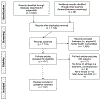The Etiologic, Theory-Based, Ontogenetic Hierarchical Framework of Alcohol Use Disorder: A Translational Systematic Review of Reviews
- PMID: 35295672
- PMCID: PMC8923643
- DOI: 10.1037/bul0000333
The Etiologic, Theory-Based, Ontogenetic Hierarchical Framework of Alcohol Use Disorder: A Translational Systematic Review of Reviews
Abstract
Modern nosologies (e.g., ICD-11, DSM-5) for alcohol use disorder (AUD) and dependence prioritize reliability and clinical presentation over etiology, resulting in a diagnosis that is not always strongly grounded in basic theory and research. Within these nosologies, DSM-5 AUD is treated as a discrete, largely categorical, but graded, phenomenon, which results in additional challenges (e.g., significant phenotypic heterogeneity). Efforts to increase the compatibility between AUD diagnosis and modern conceptualizations of alcohol dependence, which describe it as dimensional and partially overlapping with other psychopathology (e.g., other substance use disorders) will inspire a stronger scientific framework and strengthen AUD's validity. We conducted a systematic review of 144 reviews to integrate addiction constructs and theories into a comprehensive framework with the aim of identifying fundamental mechanisms implicated in AUD. The product of this effort was the Etiologic, Theory-Based, Ontogenetic Hierarchical Framework (ETOH Framework) of AUD mechanisms, which outlines superdomains of cognitive control, reward, as well as negative valence and emotionality, each of which subsume narrower, hierarchically-organized components. We also outline opponent processes and self-awareness as key moderators of AUD mechanisms. In contrast with other frameworks, we recommend an increased conceptual role for negative valence and compulsion in AUD. The ETOH framework serves as a critical step towards conceptualizations of AUD as dimensional and heterogeneous. It has the potential to improve AUD assessment and aid in the development of evidence-based diagnostic measures that focus on key mechanisms in AUD, consequently facilitating treatment matching.
Keywords: addiction; alcohol use disorder; classification; diagnosis; heterogeneity; multidimensionality; systematic review of reviews; transdiagnostic; translational.
Figures


Similar articles
-
Development and psychometric analysis of the Brief DSM-5 Alcohol Use Disorder Diagnostic Assessment: Towards effective diagnosis in college students.Psychol Addict Behav. 2017 Nov;31(7):797-806. doi: 10.1037/adb0000320. Psychol Addict Behav. 2017. PMID: 29144150
-
The harmful dysfunction model of alcohol use disorder: revised criteria to improve the validity of diagnosis and prevalence estimates.Addiction. 2015 Jun;110(6):931-42. doi: 10.1111/add.12859. Epub 2015 Feb 24. Addiction. 2015. PMID: 25622535
-
The etiology of DSM-5 alcohol use disorder: Evidence of shared and non-shared additive genetic effects.Drug Alcohol Depend. 2019 Aug 1;201:147-154. doi: 10.1016/j.drugalcdep.2018.12.034. Epub 2019 Jun 14. Drug Alcohol Depend. 2019. PMID: 31229702 Free PMC article.
-
Substance use disorders: Diagnostic and Statistical Manual of Mental Disorders, fourth edition (DSM-IV) and International Classification of Diseases, tenth edition (ICD-10).Addiction. 2006 Sep;101 Suppl 1:59-75. doi: 10.1111/j.1360-0443.2006.01584.x. Addiction. 2006. PMID: 16930162 Review.
-
Diagnosis, course, and assessment of alcohol abuse and dependence in adolescents.Recent Dev Alcohol. 2005;17:5-27. doi: 10.1007/0-306-48626-1_1. Recent Dev Alcohol. 2005. PMID: 15789857 Review.
Cited by
-
Alcohol use disorder conceptualizations and diagnoses reflect their sociopolitical context.Addict Res Theory. 2023;31(5):307-312. doi: 10.1080/16066359.2022.2150935. Epub 2022 Dec 6. Addict Res Theory. 2023. PMID: 37981984 Free PMC article.
-
Reducing Stigma and Enhancing Care for People Who Use Alcohol.J Health Serv Psychol. 2025 Feb;51(1):31-41. doi: 10.1007/s42843-025-00124-8. Epub 2025 Mar 13. J Health Serv Psychol. 2025. PMID: 40276597
-
Rasch analysis of DSM-5 alcohol use disorder in a large inpatient sample.Alcohol Clin Exp Res (Hoboken). 2025 May;49(5):1076-1085. doi: 10.1111/acer.70029. Epub 2025 Apr 11. Alcohol Clin Exp Res (Hoboken). 2025. PMID: 40214210 Free PMC article.
-
Examining the longer-term efficacy of brief, alcohol-focused personalized feedback interventions for individuals with internalizing distress: Secondary analysis of a randomized controlled trial.Addiction. 2025 Aug;120(8):1666-1678. doi: 10.1111/add.70044. Epub 2025 Apr 9. Addiction. 2025. PMID: 40202024 Free PMC article. Clinical Trial.
-
Construct validity of DSM-5 cannabis use disorder diagnosis and severity levels in adults with problematic substance use.J Psychiatr Res. 2022 Nov;155:387-394. doi: 10.1016/j.jpsychires.2022.09.016. Epub 2022 Sep 21. J Psychiatr Res. 2022. PMID: 36182768 Free PMC article.
References
-
- *Agrawal A, & Lynskey MT (2014). Genetics of Substance Use Disorders. In Rhee S & Ronald A (Eds.), Behavior Genetics of Psychopathology (pp. 185–230). Springer, New York, NY. 10.1007/978-1-4614-9509-3_7 - DOI

